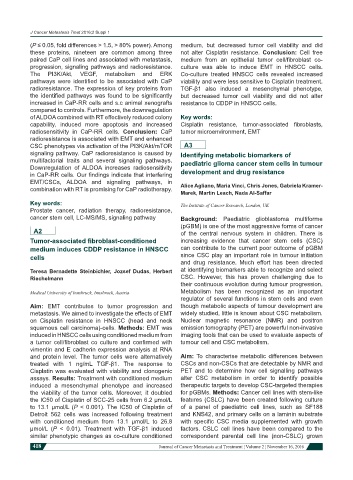Page 428 - Read Online
P. 428
J Cancer Metastasis Treat 2016;2 Suppl 1
(P ≤ 0.05, fold differences > 1.5, > 80% power). Among medium, but decreased tumor cell viability and did
these proteins, nineteen are common among three not alter Cisplatin resistance. Conclusion: Cell free
paired CaP cell lines and associated with metastasis, medium from an epithelial tumor cell/fibroblast co-
progression, signaling pathways and radioresistance. culture was able to induce EMT in HNSCC cells.
The PI3K/Akt, VEGF, metabolism and ERK Co-culture treated HNSCC cells revealed increased
pathways were identified to be associated with CaP viability and were less sensitive to Cisplatin treatment.
radioresistance. The expression of key proteins from TGF-β1 also induced a mesenchymal phenotype,
the identified pathways was found to be significantly but decreased tumor cell viability and did not alter
increased in CaP-RR cells and s.c animal xenografts resistance to CDDP in HNSCC cells.
compared to controls. Furthermore, the downregulation
of ALDOA combined with RT effectively reduced colony Key words:
capability, induced more apoptosis and increased Cisplatin resistance, tumor-associated fibroblasts,
radiosensitivity in CaP-RR cells. Conclusion: CaP tumor microenvironment, EMT
radioresistance is associated with EMT and enhanced
CSC phenotypes via activation of the PI3K/Akt/mTOR A3
signaling pathway. CaP radioresistance is caused by Identifying metabolic biomarkers of
multifactorial traits and several signaling pathways. paediatric glioma cancer stem cells in tumour
Downregulation of ALDOA increases radiosensitivity
in CaP-RR cells. Our findings indicate that interfering development and drug resistance
EMT/CSCs, ALDOA and signaling pathways, in Alice Agliano, Maria Vinci, Chris Jones, Gabriela Kramer-
combination with RT is promising for CaP radiotherapy.
Marek, Martin Leach, Nada Al-Saffar
Key words: The Institute of Cancer Research, London, UK
Prostate cancer, radiation therapy, radioresistance,
cancer stem cell, LC-MS/MS, signaling pathway Background: Paediatric glioblastoma multiforme
(pGBM) is one of the most aggressive forms of cancer
A2 of the central nervous system in children. There is
Tumor-associated fibroblast-conditioned increasing evidence that cancer stem cells (CSC)
medium induces CDDP resistance in HNSCC can contribute to the current poor outcome of pGBM
cells since CSC play an important role in tumour initiation
and drug resistance. Much effort has been directed
Teresa Bernadette Steinbichler, Jozsef Dudas, Herbert at identifying biomarkers able to recognize and select
Riechelmann CSC. However, this has proven challenging due to
their continuous evolution during tumour progression.
Medical University of Innsbruck, Innsbruck, Austria Metabolism has been recognized as an important
regulator of several functions in stem cells and even
Aim: EMT contributes to tumor progression and though metabolic aspects of tumour development are
metastasis. We aimed to investigate the effects of EMT widely studied, little is known about CSC metabolism.
on Cisplatin resistance in HNSCC (head and neck Nuclear magnetic resonance (NMR) and positron
squamous cell carcinoma)-cells. Methods: EMT was emission tomography (PET) are powerful non-invasive
induced in HNSCC cells using conditioned medium from imaging tools that can be used to evaluate aspects of
a tumor cell/fibroblast co culture and confirmed with tumour cell and CSC metabolism.
vimentin and E cadherin expression analysis at RNA
and protein level. The tumor cells were alternatively Aim: To characterise metabolic differences between
treated with 1 ng/mL TGF-β1. The response to CSCs and non-CSCs that are detectable by NMR and
Cisplatin was evaluated with viability and clonogenic PET and to determine how cell signalling pathways
assays. Results: Treatment with conditioned medium alter CSC metabolism in order to identify possible
induced a mesenchymal phenotype and increased therapeutic targets to develop CSC-targeted therapies
the viability of the tumor cells. Moreover, it doubled for pGBMs. Methods: Cancer cell lines with stem-like
the IC50 of Cisplatin of SCC-25 cells from 6.2 μmol/L features (CSLC) have been created following culture
to 13.1 μmol/L (P < 0.001). The IC50 of Cisplatin of of a panel of paediatric cell lines, such as SF188
Detroit 562 cells was increased following treatment and KNS42, and primary cells on a laminin substrate
with conditioned medium from 13.1 μmol/L to 26.8 with specific CSC media supplemented with growth
μmol/L (P < 0.01). Treatment with TGF-β1 induced factors. CSLC cell lines have been compared to the
similar phenotypic changes as co-culture conditioned correspondent parental cell line (non-CSLC) grown
418
Journal of Cancer Metastasis and Treatment ¦ Volume 2 ¦ November 16, 2016

